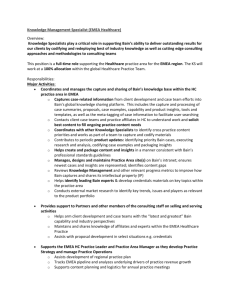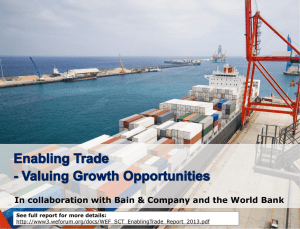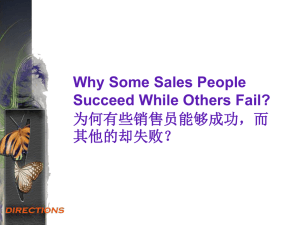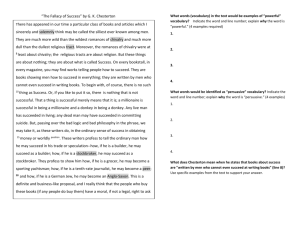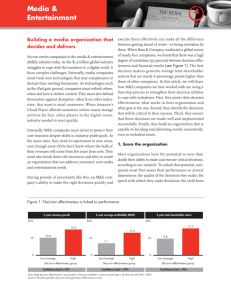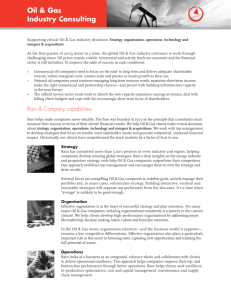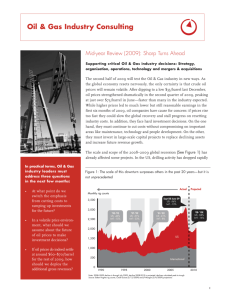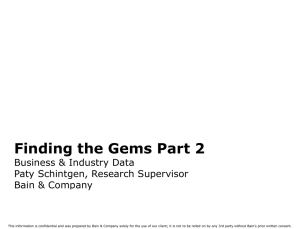Leadership - The California and Nevada Credit Union Leagues
advertisement
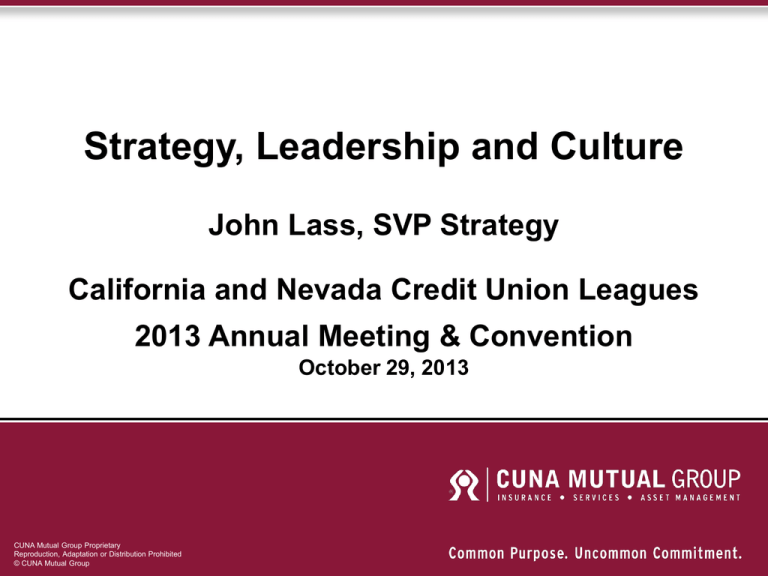
Strategy, Leadership and Culture John Lass, SVP Strategy California and Nevada Credit Union Leagues 2013 Annual Meeting & Convention October 29, 2013 CUNA Mutual Group Proprietary Reproduction, Adaptation or Distribution Prohibited © CUNA Mutual Group Sequence of Themes • 2011: Sustainable Growth Model • 2012: Strategic Inflection Point • 2013: Battle for the American Consumer 2 Strategic Inflection Point Business goes on to newer heights Inflection Point Business declines Source: Only the Paranoid Survive, Andrew S. Grove, 1996 3 The Battle for the American Consumer Financial Institutions Non-Bank Competitors Retailers Financial Services Savings Card Companies Lending Platform Players Payments Investments Insurance New Entrants Telecoms Alternative Payments Source: BDU Analysis 4 Two Key Questions Q: Are credit unions facing a strategic inflection point? A: The evidence points to “Yes”: – Proliferation of competitors and substitutes – Channel shifts – Regulatory burden – Changing of the leadership guard – And many other factors… Q: How can we manage through the strategic inflection point? 5 Strategy, Leadership and Culture Strategy Leadership Culture Source: CUNA Mutual Group – BDU Analysis 6 Strategy 7 Definition of Strategy “The determination of the long-run goals and objectives of an enterprise and the adoption of courses of action and the allocation of resource necessary for carrying out these goals” - Alfred Chandler, Strategy and Structure,1962 8 Amazon Business & Investing Titles by Keyword Source: Amazon.com, 7/23/2013 9 Definition of Strategy “Strategy is that which links an organization’s objectives to its actions.” - Bruce Henderson, Founder, Boston Consulting Group, 1968 10 High BCG Growth Share Matrix Low Market Growth High Low Market Share 11 High BCG Growth Share Matrix Low Market Growth High Low Market Share 12 High BCG Growth Share Matrix Low Market Growth High Low Market Share 13 High BCG Growth Share Matrix Low Market Growth High Low Market Share 14 High BCG Growth Share Matrix Market Growth Low X High Low Market Share 15 Michael Porter’s Definition of Strategy “Competitive strategy is about being different. It means deliberately choosing a different set of activities to deliver a unique mix of value.” - Michael Porter, “What is Strategy?”, Harvard Business Review, 1996 16 Strategy Options: What Customer Value to Lead in? To compete, a business needs to perform in all three disciplines. To become a market leader, it must outperform competitors in one discipline. Product Innovation Leadership We win because the market perceives our brand as having the cutting-edge (often overkill) products with superior features – justifying premium prices. Example: Apple Computer Middle ground of mediocracy: Trying to lead on all fronts Customer Solutions Leadership Operational Efficiency Leadership We win because the market perceives us as having the lowest prices. Based on cost and process efficiencies that still allow us to return profits. We win because we are so customerintimate that we are already there when the customer need arises. We offer tailored solutions before the customer feels like shopping around. Example: IBM w/ enterprise customers. Example: Dell Computer Source: The Discipline of Market Leaders, Michael Treacy & Fred Wiersma, 1995 17 Case Study: Specialty Coffee Retailers Product Innovation Leadership Customer Centricity Operational Efficiency Leadership Source: BDU Analysis 18 Strategy Exercise Product Innovation Leadership Three Questions: 1. Where is my credit union today? 2. Where are each of my three top competitors? 3. Where should my credit union be three years from today? Customer Centricity Operational Efficiency Leadership Source: BDU Analysis 19 The Role Of Strategy Objectives Strategy Action Plan 20 The Role Of Strategy Vision Values Mission Objectives Strategy Action Plan 21 The Role Of Strategy Vision Values Mission Objectives Strategy Action Plan Measurement Controls Iteration 22 Strategy: Discussion Questions • Does our strategy respond to the realities of the strategic inflection point? • Do we have a financial / business model that can sustain growth for the next decade? • What will happen if we fail to respond? • How urgent is the current situation? 23 Leadership 24 Teddy Roosevelt on Leadership “The first duty of a leader is to lead.” - Theodore Roosevelt Source: Theodore Roosevelt's History of the United States: His Own Words, Daniel Ruddy, 2010 25 Leadership Defined "Leadership is the art of influencing human behavior through ability to directly influence people and direct them toward a specific goal.“ - Gen Omar N. Bradley, Chief of Staff, U.S. Army, 1948 Source: Command, Leadership, And Effective Staff Support, The Information Management Support Center, Department of the Army, 1996 26 Key Leadership Attributes • Integrity • Self-awareness • Adaptability and flexibility • Intellectual versatility • Interpersonal influence • Objectivity • Organizational savvy • Self-confidence • Tolerance of ambiguity Source” “Foundations for Successful Leadership – Key Leadership Attributes”, University of Michigan Health System 27 Myers Briggs Personality Types The way you take in information Where you focus your attention The way you make decisions How you deal with the outside world E S T J Extroverted Sensing Thinking Judging I N F P Introverted Intuitive Feeling Perceiving 28 Hagberg’s Three Pillars of Leadership Visionary Evangelist • • • • • Visionary thinking Taking initiative Agent of change Inspirational role model Strategic focus Relationship Builder • Sensitivity and consideration • Relationship building • Openness to input • Social Astuteness • Listening Manager of Execution • Results and productivity • Planning, prioritizing and maintaining focus • Re-engineering processes • Dependability • Developing structures, systems and processes Source: Hagberg Consulting Group 29 Leadership Styles and Value Proposition Product Innovation Leadership Customer Centricity Steve Jobs / Apple Visionary Evangelist Operational Efficiency Leadership Middle ground of mediocrity: Trying to lead on all fronts Sam Palmisano / IBM Relationship Builder Michael Dell / Dell Inc. Manager of Execution 30 Leadership Key Points • Many different styles of leadership • In many cases different leadership styles correlate to different personality traits (Myers Briggs) – Leaders tend not to change from one style to another – Leaders cannot master all styles • Leader must fit the value proposition • Build upon a leader’s strengths and work around weaknesses • Surround leaders with teams that augment them 31 Leadership: Discussion Questions • Who has a vision of what life looks like beyond the strategic inflection point? • What leadership skills and competencies are most critical at this stage of my credit union’s development? • What needs to be done to cultivate the next generation of credit union leaders? 32 Culture 33 Culture Defined “Culture refers to the taken-for-granted values, underlying assumptions, expectations and definitions that characterize organizations and their members… It serves as the social glue binding an organization together.” - Diagnosing and Changing Organizational Culture, Cameron & Quinn, 2011 34 Another Definition of Culture “The force that determines how people behave when no one is looking.” - Building a Winning Culture, Bain and Company, 2006 35 Elements of Organizational Culture Observable Explicit Behaviors Artifacts Conscious Contracts and Norms Implicit Assumptions Unobservable Source: Diagnosing and Changing Organizational Culture, Kim S. Cameron and Robert E. Quinn, 2011 36 Importance of Culture “A strong culture has almost always been the driving force behind the continuing success in American business.” - Corporate cultures: the rites and rituals of corporate life, Terrence Deal and Allan Kennedy, 1982 37 Winning Cultures Combine Two Key Elements High aspirations and a desire to win High Performance Values & Behaviors: Passion and energy External focus Significant similarities exist across highperforming companies Who we are / what we value Unique Personality and Soul: Every high-performing company is unique Think like owners Individuals who team Bias to action Source: “Building a winning culture”, Bain & Co., 2006 38 Bain Survey of Business Leaders 68% Believe culture provides the greatest source of competitive advantage Source: “Building a winning culture”, Bain & Co., 2006 39 Bain Survey of Business Leaders 68% Believe culture provides the greatest source of competitive advantage 76% Believe it’s changeable Source: “Building a winning culture”, Bain & Co., 2006 40 Bain Survey of Business Leaders 68% Believe culture provides the greatest source of competitive advantage 76% Believe it’s changeable 65% Believe they need to change it Source: “Building a winning culture”, Bain & Co., 2006 41 Bain Survey of Business Leaders 68% Believe culture provides the greatest source of competitive advantage 76% Believe it’s changeable 65% Believe they need to change it 81% Believe an organization lacking a high-performance culture is doomed to mediocrity Source: “Building a winning culture”, Bain & Co., 2006 42 Bain Survey of Business Leaders 68% Believe culture provides the greatest source of competitive advantage 76% Believe it’s changeable 65% Believe they need to change it 81% Believe an organization lacking a high-performance culture is doomed to mediocrity 10% Succeed in building a high-performance culture Source: “Building a winning culture”, Bain & Co., 2006 43 Why Culture is so Difficult to Change “Culture is so stable and difficult to change because it represents the accumulated learning of a group – the ways of thinking, feeling and perceiving the world that have made the group successful.” - The Corporate Culture Survival Guide, Edgar Schein, 2009 Source: “Building a winning culture”, Bain & Co., 2006 44 Successful Cultural Change • Determine what type of culture the business needs • Identify specific attributes that make up the ideal culture • Manage the factors that shape and influence culture 45 Culture Key Points • Most difficult of the three to identify and define – Impact is real if not more real than strategy and leadership • Once established culture can be difficult to change • Some believe that culture cannot be changed directly – Change individual and group behavior over time and the culture will change – Employment practices have a big impact on culture • Buy-in from senior leadership is critical to any culture change effort 46 Lou Gerstner’s Perspective “Culture isn’t just one aspect of the game. It is the game.” - Lou Gerstner, Former Chairman, IBM 47 Culture: Discussion Questions • Do we have a realistic assessment of the cultural strengths and weaknesses of our credit union? • Does our organizational culture need to change? • What are the most important culture attributes to support our long-term success and relevance? • Will the required culture change cause us to look more like our competition? 48 Alignment of Strategy, Leadership and Culture 49 The Convergence of Strategy and Leadership • Strategy and leadership are always inextricably bound up with each other – A strong leader is involved at every stage of strategy: • Initial conception • Development • Full articulation and communication • Final execution • At certain times the linkage between strategy and leadership is critical: – At the national level: In times of war and economic crisis – At the corporate level: At strategic inflection points 50 Winston Churchill on Execution “Any clever person can make plans for winning a war if he has no responsibility for carrying them out.” Source: The Wit and Wisdom of Winston Churchill: A Treasury of More than 1000 Quotations, James C. Humes, 2009 51 Link between Strategy and Culture Primary Value Proposition Supportive Culture Elements Product Innovation • Nimbleness • Committed to Excellence Operational Efficiency Customized Solutions • Systems and Procedures • Customer Driven • Committed to Excellence • Learning • Committed to Excellence • Acceptance of Change • Time Horizon • Nimbleness • Creativity and Innovation • External Focus • Support Employee Growth • Risk Taking • Learning • Nimbleness • Learning • Creativity and Innovation • Acceptance of Change Source: Hagberg Consulting Group 52 Dilbert on Execution Source: Dilbert by Scott Adams 53 Aligning Strategy with Leadership and Culture Source: Hagberg Consulting Group 54 Culture: Ignore It At Your Peril “In general, culture is stronger than the new leader and either limits or ignores new leaders who do not fit into the culture.” - Edgar Schein “Culture eats strategy for breakfast.” - Peter Drucker Source: “Dr. Edgar Schein on Culture, Leadership and Performance”, Doctor Duncan Blog, 10/16/2012 55 Alignment Process: Case Study Strategy Drives Culture, Leadership and Structure: One Size Does Not Fit All: Design, Assess, Act and Re-Examine Vision, Mission, Values Strategy: Customer Intimacy, Operational Excellence, Product Leadership, Disruptive Innovation Culture: What are the culture characteristics required to support the strategy? Leadership: What are the leadership competencies required to support the strategy? Structure: What is the organization structure required to support the strategy? Required Culture Exercise Identify leadership competencies Design/determine optimal structure Culture Assessment 360° Feedback/personality profile Assess current structure Identify gaps between required and actual culture. Target change efforts. Development Plan and Coaching Identify areas to restructure. Modify structure. Source: John Stieber Consulting 56 Alignment: Discussion Questions • Do we need to modify our strategy to survive and thrive? • Is our culture capable of supporting a strategic shift? • Do our leaders possess the vision and skills required to lead us through the strategic inflection point? 57 Winston Churchill on Responsibility “Someone has to take responsibility. I will.” Source: Churchill on Leadership. Steven F. Hayward, 2010 58 The Final Word Someone has to take responsibility. We will. 59 Important Disclaimer CUNA Mutual’s analysis is based upon certain publicly available information and data, including NCUA 5300 Reports, and is subject to risks, uncertainties and other factors which could cause actual results or performance to differ from the future results or performance expressed or implied in this analysis. We disclaim any representation or warranty, express or implied, as to the accuracy or completeness of our analysis, as well as any obligation to update our analysis. Each recipient should conduct its own independent analysis of relevant information and data, and should base any business decisions upon such independent analysis. www.sustainablegrowthblog.blogspot.com 60



